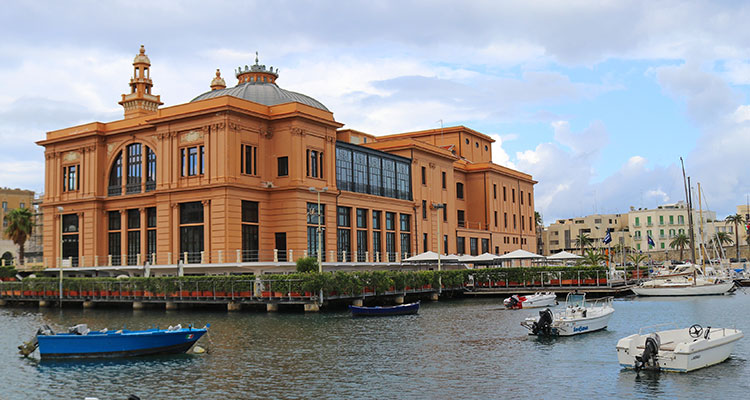Italy is a country known for its rich cultural heritage, and one of the prominent jewels in its artistic crown is Teatro Margherita in Bari. Nestled along the Adriatic coast, Bari is a bustling port city in the Apulia region that has witnessed centuries of history and culture. Amidst its charming streets and picturesque waterfront, Teatro Margherita stands as a testament to the city’s devotion to the performing arts. In this article, we will delve into the captivating history of Teatro Margherita, exploring its significance, architectural splendor, and the impact it has had on the local community and beyond.
The Birth of Teatro Margherita
Teatro Margherita, also known as “Teatro di Corte,” came into existence at the turn of the 20th century. The theater was commissioned by King Umberto I of Italy to commemorate the 50th anniversary of the unification of Italy in 1911. Designed by renowned architect Luigi Santarella, the theater was named after Queen Margherita of Savoy, who was the wife of King Umberto I. Teatro Margherita was initially intended to serve as an entertainment hub for the royal family and the aristocracy, hosting grand opera performances, ballets, and theatrical productions.
Architectural Splendor
Teatro Margherita boasts an impressive architectural style, representing a captivating fusion of different artistic movements. The façade of the theater features a combination of Neo-Renaissance and Art Nouveau elements, displaying intricate sculptures and ornate decorations. The grand entrance is adorned with columns and statues, welcoming visitors into the opulent world of the performing arts.

The interior of the theater is equally breathtaking. The auditorium is adorned with lavish decorations, including intricately designed frescoes, stuccoes, and gilded accents. The central dome, adorned with beautiful paintings, stands as the centerpiece of the theater, drawing the gaze of all who enter. The attention to detail in every aspect of the architecture showcases the dedication to creating a space that celebrates the arts in all their grandeur.
Heyday and Decline
In its early years, Teatro Margherita thrived as a premier cultural venue, hosting celebrated artists, musicians, and performers from all over the world. It became a symbol of Bari’s cultural prowess, attracting both locals and tourists alike. However, like many historical theaters, Teatro Margherita faced its fair share of challenges.
With the advent of cinema and television, the popularity of live performances declined, leading to a decrease in theater attendance. The grand opera productions that once graced the stage were now struggling to fill the seats. As the decades passed, the theater fell into a state of neglect, and its glory began to fade.
Restoration and Revival
Recognizing the historical and cultural significance of Teatro Margherita, local authorities and cultural enthusiasts rallied together to rescue the theater from oblivion. In the early 2000s, an extensive restoration project was undertaken to bring back the former splendor of the theater. The restoration process involved meticulous work to preserve the original architectural elements while integrating modern amenities and safety features.
Today, Teatro Margherita stands proudly as a beautifully restored cultural icon. While it still hosts traditional performances, the theater has also adapted to contemporary trends, welcoming diverse cultural events, music concerts, and even movie screenings.
Impact on the Community
Teatro Margherita’s revival has had a profound impact on the community of Bari. It has become a vibrant cultural hub, fostering a sense of pride and appreciation for the arts among residents. The theater’s diverse program of events caters to various tastes, attracting audiences of all ages and backgrounds. This inclusivity has helped bridge generational and cultural gaps, nurturing a shared passion for creativity and artistic expression.
Additionally, the restoration of Teatro Margherita has breathed new life into the surrounding neighborhood. As cultural tourism has grown, local businesses, such as cafes, restaurants, and artisan shops, have thrived, benefiting from the increased foot traffic generated by theater-goers and visitors.
Conclusion
Teatro Margherita of Bari stands as an enduring symbol of Italy’s commitment to preserving its cultural heritage. From its grand inauguration to its decline and subsequent revival, the theater’s journey reflects the ever-changing landscape of the performing arts.
As we celebrate the restoration of this architectural gem, we are reminded of the importance of cherishing our cultural treasures. Teatro Margherita continues to inspire and entertain, enriching the lives of its audience and the community at large. A testament to the power of the arts, Teatro Margherita reminds us that culture is a vibrant thread that weaves together the fabric of our shared human experience.
External Links:
- Teatro Margherita Official Website – For current events, ticket information, and guided tours, visit the official website of Teatro Margherita.
- Bari Tourism Board – Explore more about Teatro Margherita and other attractions in Bari through the official tourism website.
- Architect Luigi Santarella – Learn about the architect behind Teatro Margherita, Luigi Santarella, on Wikipedia (Italian page).
- Rediscovering Italian Opera – This New York Times article discusses the revival of interest in Italian opera and its impact on historic theaters like Teatro Margherita.
- Apulia: The Hidden Gem of Southern Italy – Discover more about the Apulia region and its cultural offerings, including Teatro Margherita, on Lonely Planet.
- Teatro Petruzzelli of Bari – Discover more about Petruzzelli
Disclaimer: The external links provided above are for reference purposes only and are not affiliated with the author or the blog platform.